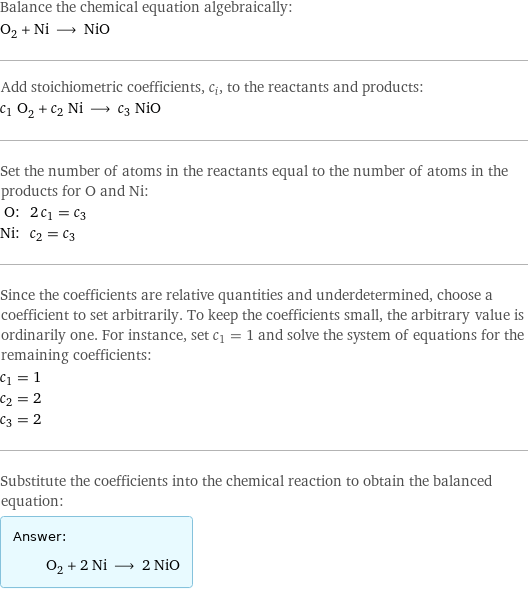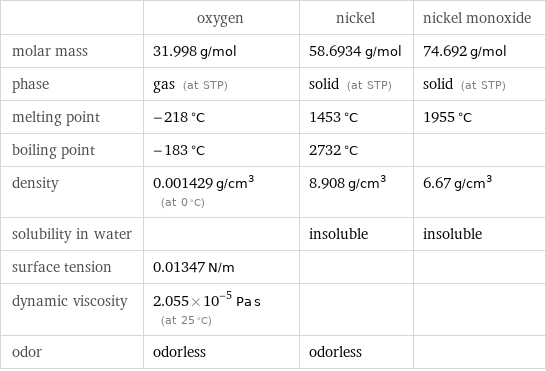Input interpretation

O_2 oxygen + Ni nickel ⟶ NiO nickel monoxide
Balanced equation

Balance the chemical equation algebraically: O_2 + Ni ⟶ NiO Add stoichiometric coefficients, c_i, to the reactants and products: c_1 O_2 + c_2 Ni ⟶ c_3 NiO Set the number of atoms in the reactants equal to the number of atoms in the products for O and Ni: O: | 2 c_1 = c_3 Ni: | c_2 = c_3 Since the coefficients are relative quantities and underdetermined, choose a coefficient to set arbitrarily. To keep the coefficients small, the arbitrary value is ordinarily one. For instance, set c_1 = 1 and solve the system of equations for the remaining coefficients: c_1 = 1 c_2 = 2 c_3 = 2 Substitute the coefficients into the chemical reaction to obtain the balanced equation: Answer: | | O_2 + 2 Ni ⟶ 2 NiO
Structures

+ ⟶
Names

oxygen + nickel ⟶ nickel monoxide
Reaction thermodynamics
Enthalpy

| oxygen | nickel | nickel monoxide molecular enthalpy | 0 kJ/mol | 0 kJ/mol | -241 kJ/mol total enthalpy | 0 kJ/mol | 0 kJ/mol | -482 kJ/mol | H_initial = 0 kJ/mol | | H_final = -482 kJ/mol ΔH_rxn^0 | -482 kJ/mol - 0 kJ/mol = -482 kJ/mol (exothermic) | |
Entropy

| oxygen | nickel | nickel monoxide molecular entropy | 205 J/(mol K) | 30 J/(mol K) | 30 J/(mol K) total entropy | 205 J/(mol K) | 60 J/(mol K) | 60 J/(mol K) | S_initial = 265 J/(mol K) | | S_final = 60 J/(mol K) ΔS_rxn^0 | 60 J/(mol K) - 265 J/(mol K) = -205 J/(mol K) (exoentropic) | |
Equilibrium constant
![Construct the equilibrium constant, K, expression for: O_2 + Ni ⟶ NiO Plan: • Balance the chemical equation. • Determine the stoichiometric numbers. • Assemble the activity expression for each chemical species. • Use the activity expressions to build the equilibrium constant expression. Write the balanced chemical equation: O_2 + 2 Ni ⟶ 2 NiO Assign stoichiometric numbers, ν_i, using the stoichiometric coefficients, c_i, from the balanced chemical equation in the following manner: ν_i = -c_i for reactants and ν_i = c_i for products: chemical species | c_i | ν_i O_2 | 1 | -1 Ni | 2 | -2 NiO | 2 | 2 Assemble the activity expressions accounting for the state of matter and ν_i: chemical species | c_i | ν_i | activity expression O_2 | 1 | -1 | ([O2])^(-1) Ni | 2 | -2 | ([Ni])^(-2) NiO | 2 | 2 | ([NiO])^2 The equilibrium constant symbol in the concentration basis is: K_c Mulitply the activity expressions to arrive at the K_c expression: Answer: | | K_c = ([O2])^(-1) ([Ni])^(-2) ([NiO])^2 = ([NiO])^2/([O2] ([Ni])^2)](../image_source/6ec0478de16e151206337fef9f3455e5.png)
Construct the equilibrium constant, K, expression for: O_2 + Ni ⟶ NiO Plan: • Balance the chemical equation. • Determine the stoichiometric numbers. • Assemble the activity expression for each chemical species. • Use the activity expressions to build the equilibrium constant expression. Write the balanced chemical equation: O_2 + 2 Ni ⟶ 2 NiO Assign stoichiometric numbers, ν_i, using the stoichiometric coefficients, c_i, from the balanced chemical equation in the following manner: ν_i = -c_i for reactants and ν_i = c_i for products: chemical species | c_i | ν_i O_2 | 1 | -1 Ni | 2 | -2 NiO | 2 | 2 Assemble the activity expressions accounting for the state of matter and ν_i: chemical species | c_i | ν_i | activity expression O_2 | 1 | -1 | ([O2])^(-1) Ni | 2 | -2 | ([Ni])^(-2) NiO | 2 | 2 | ([NiO])^2 The equilibrium constant symbol in the concentration basis is: K_c Mulitply the activity expressions to arrive at the K_c expression: Answer: | | K_c = ([O2])^(-1) ([Ni])^(-2) ([NiO])^2 = ([NiO])^2/([O2] ([Ni])^2)
Rate of reaction
![Construct the rate of reaction expression for: O_2 + Ni ⟶ NiO Plan: • Balance the chemical equation. • Determine the stoichiometric numbers. • Assemble the rate term for each chemical species. • Write the rate of reaction expression. Write the balanced chemical equation: O_2 + 2 Ni ⟶ 2 NiO Assign stoichiometric numbers, ν_i, using the stoichiometric coefficients, c_i, from the balanced chemical equation in the following manner: ν_i = -c_i for reactants and ν_i = c_i for products: chemical species | c_i | ν_i O_2 | 1 | -1 Ni | 2 | -2 NiO | 2 | 2 The rate term for each chemical species, B_i, is 1/ν_i(Δ[B_i])/(Δt) where [B_i] is the amount concentration and t is time: chemical species | c_i | ν_i | rate term O_2 | 1 | -1 | -(Δ[O2])/(Δt) Ni | 2 | -2 | -1/2 (Δ[Ni])/(Δt) NiO | 2 | 2 | 1/2 (Δ[NiO])/(Δt) (for infinitesimal rate of change, replace Δ with d) Set the rate terms equal to each other to arrive at the rate expression: Answer: | | rate = -(Δ[O2])/(Δt) = -1/2 (Δ[Ni])/(Δt) = 1/2 (Δ[NiO])/(Δt) (assuming constant volume and no accumulation of intermediates or side products)](../image_source/ece957f8eb15e50dd14dbd633fc3511b.png)
Construct the rate of reaction expression for: O_2 + Ni ⟶ NiO Plan: • Balance the chemical equation. • Determine the stoichiometric numbers. • Assemble the rate term for each chemical species. • Write the rate of reaction expression. Write the balanced chemical equation: O_2 + 2 Ni ⟶ 2 NiO Assign stoichiometric numbers, ν_i, using the stoichiometric coefficients, c_i, from the balanced chemical equation in the following manner: ν_i = -c_i for reactants and ν_i = c_i for products: chemical species | c_i | ν_i O_2 | 1 | -1 Ni | 2 | -2 NiO | 2 | 2 The rate term for each chemical species, B_i, is 1/ν_i(Δ[B_i])/(Δt) where [B_i] is the amount concentration and t is time: chemical species | c_i | ν_i | rate term O_2 | 1 | -1 | -(Δ[O2])/(Δt) Ni | 2 | -2 | -1/2 (Δ[Ni])/(Δt) NiO | 2 | 2 | 1/2 (Δ[NiO])/(Δt) (for infinitesimal rate of change, replace Δ with d) Set the rate terms equal to each other to arrive at the rate expression: Answer: | | rate = -(Δ[O2])/(Δt) = -1/2 (Δ[Ni])/(Δt) = 1/2 (Δ[NiO])/(Δt) (assuming constant volume and no accumulation of intermediates or side products)
Chemical names and formulas

| oxygen | nickel | nickel monoxide formula | O_2 | Ni | NiO name | oxygen | nickel | nickel monoxide IUPAC name | molecular oxygen | nickel | oxonickel
Substance properties

| oxygen | nickel | nickel monoxide molar mass | 31.998 g/mol | 58.6934 g/mol | 74.692 g/mol phase | gas (at STP) | solid (at STP) | solid (at STP) melting point | -218 °C | 1453 °C | 1955 °C boiling point | -183 °C | 2732 °C | density | 0.001429 g/cm^3 (at 0 °C) | 8.908 g/cm^3 | 6.67 g/cm^3 solubility in water | | insoluble | insoluble surface tension | 0.01347 N/m | | dynamic viscosity | 2.055×10^-5 Pa s (at 25 °C) | | odor | odorless | odorless |
Units
